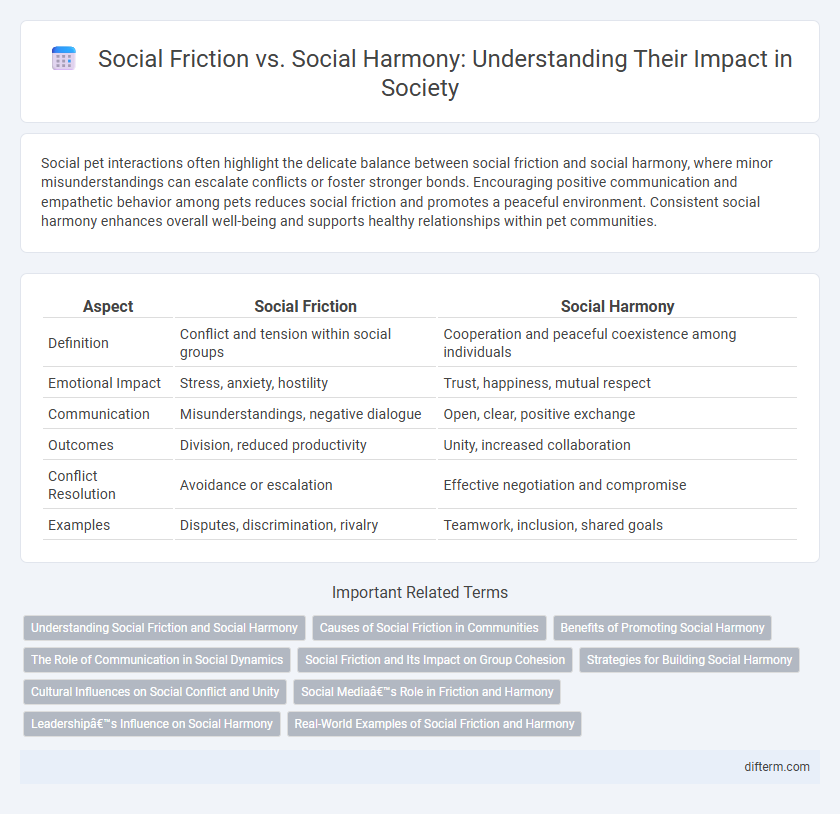Social pet interactions often highlight the delicate balance between social friction and social harmony, where minor misunderstandings can escalate conflicts or foster stronger bonds. Encouraging positive communication and empathetic behavior among pets reduces social friction and promotes a peaceful environment. Consistent social harmony enhances overall well-being and supports healthy relationships within pet communities.
Table of Comparison
| Aspect | Social Friction | Social Harmony |
|---|---|---|
| Definition | Conflict and tension within social groups | Cooperation and peaceful coexistence among individuals |
| Emotional Impact | Stress, anxiety, hostility | Trust, happiness, mutual respect |
| Communication | Misunderstandings, negative dialogue | Open, clear, positive exchange |
| Outcomes | Division, reduced productivity | Unity, increased collaboration |
| Conflict Resolution | Avoidance or escalation | Effective negotiation and compromise |
| Examples | Disputes, discrimination, rivalry | Teamwork, inclusion, shared goals |
Understanding Social Friction and Social Harmony
Social friction arises from conflicting interests, values, and communication barriers within diverse groups, often leading to misunderstandings and tension. Social harmony is achieved through effective conflict resolution, mutual respect, and shared goals that foster cooperation and collective well-being. Understanding the dynamics of social friction versus social harmony enables communities to develop strategies that promote inclusivity and sustained peaceful interactions.
Causes of Social Friction in Communities
Social friction in communities often arises from cultural differences, economic inequality, and communication barriers that hinder mutual understanding. Power imbalances and competition for resources intensify conflicts, leading to mistrust among group members. Addressing these root causes through inclusive dialogue and equitable policies promotes social harmony and cohesion.
Benefits of Promoting Social Harmony
Promoting social harmony fosters stronger community bonds and enhances collaborative efforts, leading to increased productivity and mutual support. It reduces conflict-related stress and resource expenditure, allowing societies to focus on collective growth and innovation. Improved social cohesion also cultivates a safer, more inclusive environment where diversity is respected and individual well-being thrives.
The Role of Communication in Social Dynamics
Effective communication plays a crucial role in reducing social friction by fostering understanding and empathy among individuals. Clear dialogue helps bridge cultural and ideological differences, promoting social harmony and collaborative problem-solving. Communication channels that encourage active listening and respectful exchange contribute significantly to the cohesion and stability of social groups.
Social Friction and Its Impact on Group Cohesion
Social friction arises from conflicts, misunderstandings, and competing interests within groups, often undermining trust and cooperation among members. This tension can reduce group cohesion by fostering divisions and impairing effective communication, critical for collective problem-solving. Persistent social friction leads to decreased morale and productivity, weakening the overall social fabric needed for sustainable collaboration.
Strategies for Building Social Harmony
Effective strategies for building social harmony involve fostering empathy through active listening and open communication, which helps reduce misunderstandings and social friction. Promoting inclusivity and respecting diverse perspectives creates a sense of belonging and mutual respect among community members. Encouraging collaborative problem-solving and shared goals enhances trust and cooperation, leading to sustained social cohesion.
Cultural Influences on Social Conflict and Unity
Cultural influences significantly shape social friction and harmony by affecting communication styles, values, and social norms within communities. Diverse cultural backgrounds can lead to misunderstandings and conflicts when differing beliefs and practices clash, while shared cultural values and inclusive practices promote social unity and cooperation. Recognizing and respecting cultural diversity is essential for mitigating social friction and fostering harmonious interactions across social groups.
Social Media’s Role in Friction and Harmony
Social media platforms amplify both social friction and harmony by enabling rapid dissemination of diverse opinions and fostering community engagement. Algorithms often prioritize emotionally charged content, escalating conflicts and polarizing users, while also providing spaces for dialogue, support networks, and collective action. Effective moderation and digital literacy are critical in balancing these dual effects to promote constructive interactions and social cohesion online.
Leadership’s Influence on Social Harmony
Effective leadership plays a crucial role in fostering social harmony by promoting inclusive communication and resolving conflicts constructively. Leaders who prioritize empathy and transparency build trust, encouraging collaboration across diverse social groups. This approach reduces social friction and strengthens community bonds essential for cohesive societies.
Real-World Examples of Social Friction and Harmony
Urban neighborhoods experiencing gentrification often face social friction as long-term residents clash with new arrivals, leading to disputes over cultural identity and resource allocation. In contrast, communities like the Scandinavian welfare states exemplify social harmony through strong social safety nets and inclusive policies that promote equality and cooperation. Social friction can escalate into protests or segregation, whereas social harmony fosters collaboration and collective well-being.
social friction vs social harmony Infographic

 difterm.com
difterm.com